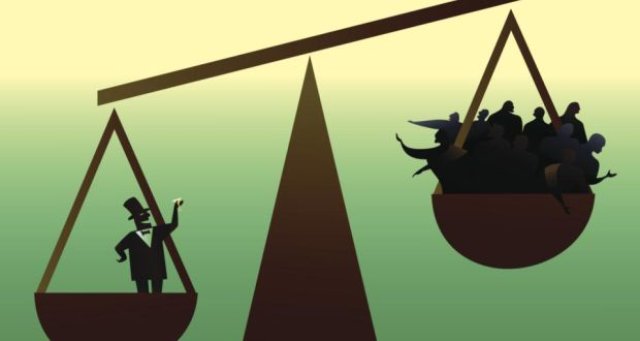
Battlers & Billionaires: The Story of Inequality in Australia
Andrew Leigh
Black Inc. Books, 2013
210 pages, $19.99 (pb)
In Australia, notes economist and Labor MP Andrew Leigh, the poorest 20% of the population own just 1% of total household wealth. The top 20%, however, hog a fat 62%.
The top 1%, meanwhile, indulge in 11%, the richest one in every 1000 Australians delight in 3% while the richest one in every million Australians — the top 0.0001% of the population, including Australia’s 32 billionaires — luxuriate in 1.4% of total wealth, or 14,000 times their population share.
Never has the shaggy myth of the vaunted Australian “egalitarian spirit” been so exposed on the rock of material inequality, says Leigh in Battlers and Billionaires, since the 1900s when vast extremes of wealth divided rich and poor.
Decades of partial income redistribution via means-tested welfare reforms and real wage growth, which led to income inequality declining to its lowest point by about 1980, have been undone by rising inequality.
The rich have accelerated away from the pack, says Leigh, who illustrates the widening wealth gap by comparing two BHP chief executives.
Essington Lewis,BHP head from 1921 to 1950, had a lifetime wealth accumulation equal to 100 times the annual average wage. But Marius Kloppers, BHP head from 2009 to 2013, took in “between 180 and 270 times the average wage in every year of his tenure”.
Over the past 30 years, Australia’s top 100 CEOs have helped deliver to the richest 1% of Australians 13% of total aggregate household income growth, a $403 billion shift in income from the bottom 99% to the top 1%.
The rising tide of economic growth does not lift all boats. Middle income earners are paddling harder to stay still while the lowest are slipping below the waves.
Contributing to rising inequality have been tax favours for the rich, a decline in trade union strength — in 1980, one in two workers were in a union, today less than one in five are — and a skewed political process in which politicians reflect the interests of their wealthiest constituents.
Leigh’s recipe for turning economic inequality around, however, fails to match his indictment. A Labor member of federal parliament, Leigh dutifully follows the party script.
Productivity is favoured — a worthy means if it means better skills and training, but one that contains the ever-present “micro-economic reform” sting of labouring harder and longer with fewer workers.
Better education for children of the poor is also meritorious. The average Year 12 student from a disadvantaged background, says Leigh, has the same literacy and numeracy skills as a Year 8 or 9 student from an advantaged background, a “brutally high barrier to further study” and higher waged jobs.
Leigh, however, avoids anything too radical, such as shifting government education funding from wealthy private schools to public schools. Such a measure could help stop these bastions of privilege acting as transmission belts of inequality through the generations.
Leigh also advocates a progressive taxation system, but is coy on whether this means raising personal top marginal tax rates — which would scare wealthy voters — and he is averse to income redistribution through raising corporate tax.
Besides, “hard-working entrepreneurs are vital to our nation’s success”, he says. They must not be hindered by business taxes or by capping CEO salaries as this will, apparently, result in low quality business executives.
Leigh’s greatest political blind spot, however, is his failure to notice that the “great divergence” in equality that resumed from around 1980 coincided, not without cause, with the advent of “neoliberalism”.
This religious revivalism of a lightly-fettered market economy ideology was pushed, in Australia, by the deregulators, privatisers and union-hobblers of Leigh’s party under the baton of Labor prime ministers Bob Hawke and Paul Keating. It was left uncorrected by the later Rudd and Gillard governments.
Leigh notes that a large majority of Australians believe that differences in income are too large and that government has a role to play in fixing this. More leopards have changed spots, however, than will modern Labor governments take to the policy barricades in the cause of equality.
Leigh refreshingly notes that economics is not about “maximising money” but “maximising well-being”. But this will not be assisted by his advocacy of ALP market managerialism as the only “left” alternative to socialism.
Leigh simplistically cites the economic and social failure of the former Soviet Union as evidence of the failure of the Marxist egalitarian principle of “from each according to their ability, to each according to their need”.
Leigh concludes that “perfect equality” is “impossible and undesirable”, producing only neo-Stalinist monotony and greyness, and that society must “reward effort” through cash.
This prescription depends on measuring personal worth by money and calibrating the merit of ideas, arts and technology by a money culture. By contrast, a democratic socialist material equality — where the battling majority would not have to worry about their next meal while a rich few, as Leigh notes, quaff their $900 bottle of 1971 Penfolds Grange Hermitage at “about $20 a sip” — is both possible and desirable.
Like the article? Subscribe to Green Left now! You can also like us on Facebook and follow us on Twitter.